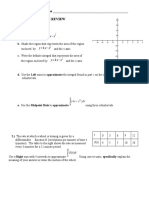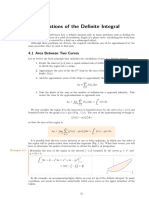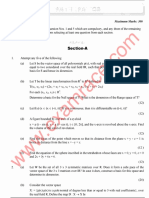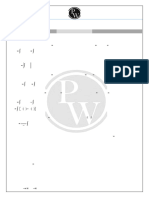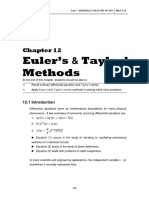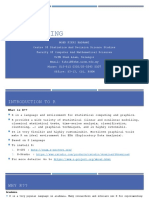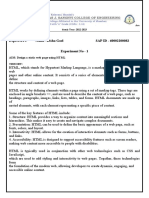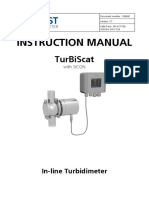m575 Chapter 10
m575 Chapter 10
Uploaded by
Raja Farhatul Aiesya Binti Raja AzharCopyright:
Available Formats
m575 Chapter 10
m575 Chapter 10
Uploaded by
Raja Farhatul Aiesya Binti Raja AzharOriginal Description:
Original Title
Copyright
Available Formats
Share this document
Did you find this document useful?
Is this content inappropriate?
Copyright:
Available Formats
m575 Chapter 10
m575 Chapter 10
Uploaded by
Raja Farhatul Aiesya Binti Raja AzharCopyright:
Available Formats
lOMoARcPSD|12841845
M575 Chapter 10
Introduction To Numerical Analysis (Universiti Teknologi MARA)
StuDocu is not sponsored or endorsed by any college or university
Downloaded by RAJA FARHATUL AIESYA RAJA AZHAR (2020859442@student.uitm.edu.my)
lOMoARcPSD|12841845
Part 6 NUMERICAL INTEGRATION MAT 575
Chapter 10
Trapezoidal
Rule
At the end of this chapter, students should be able to:
Derive trapezoidal rule
Identify and apply trapezoidal rule
Determine error involved in trapezoidal rule
10.1 Introduction
From calculus books it is stated that the area under the graph for a given
function f(x) can be computed by evaluating definite integral, i.e.
b
Area f ( x ) dx
a
There are other problems involving integration such as finding volume and arc
length.
b b
Volume xf( x ) dx or Arc length 1 f ' ( x )2 dx
a a
b
The definite integral f ( x ) dx can be computed once the function whose
a
differential; f(x) is determined. Unfortunately, this is not always possible
because
(a) it may not be possible to express the result of integration in terms of
known elementary functions such as
151
Downloaded by RAJA FARHATUL AIESYA RAJA AZHAR (2020859442@student.uitm.edu.my)
lOMoARcPSD|12841845
Part 6 NUMERICAL INTEGRATION MAT 575
1 2 b cos x
x
e dx dx
0 and a x
(b) numerical integration may be easier or quicker than calculating from the
function obtained by formal integration; or
(c) no analytical expression for the function to be integrated may be available
since the available information is being restricted to tabulated values.
b
However, the definite integral f ( x ) dx is a number which represents the area
a
between y = f(x), the x-axis and the ordinates x = a and x = b. So, even if
b b
f ( x ) dx cannot be found, an approximate value for f ( x ) dx can be found by
a a
evaluating appropriate area using one of the numerical methods to be
discussed in this chapter.
y = f(x)
b
f ( x ) dx
a
x
a b
Figure 10.1:
Trapezoidal rule
Simpson’s rule
Simpson’s 3/8 rule
10.2 Trapezoidal Rule
For definite integrals which fall into the criteria mentioned above then a
numerical method can be used to approximate the value of these integrals.
One of the numerical methods is known as trapezoidal rule. Before we moved
further let’s define the term ‘trapezoid’.
152
Downloaded by RAJA FARHATUL AIESYA RAJA AZHAR (2020859442@student.uitm.edu.my)
lOMoARcPSD|12841845
Part 6 NUMERICAL INTEGRATION MAT 575
Definition
A trapezoid (trapezium) is a quadrilateral with one pair of opposite sides
parallel.
y0 y1
h
Figure 10.2: A trapezoid
The area of a trapezoid is
1
T (sums of parallel sides)(distance betw een them)
2
1
( y0 y1)h
2
b
Let’s consider the definite integral f ( x ) dx assuming that f(x) is continuous
a
on [a, b].
y
y1
y2
y0
y3
y4
h h h h
x
a b
Figure 10.3:
b
If the area represented by f ( x ) dx is divided into 4 smaller subintervals, each
a
of equal width h as shown in Figure 10.1, then each subinterval is
approximately a trapezoid.
Using the sum of the areas of these subintervals as an approximation for the
actual value of the area we have
153
Downloaded by RAJA FARHATUL AIESYA RAJA AZHAR (2020859442@student.uitm.edu.my)
lOMoARcPSD|12841845
Part 6 NUMERICAL INTEGRATION MAT 575
b
f ( x ) dx A 1 A 2 A 3 A 4
a
1 1
where A1 ( f0 f1)h i.e. An (fn-1 fn )h
2 2
Therefore,
b
f ( x ) dx A 1 A 2 A 3 A 4
a
1 1 1 1
( f0 f1)h ( f1 f2 )h (f2 f3 )h ( f3 f4 )h
2 2 2 2
h
(f0 2f1 2f2 2f3 f4 )
2
This method is known as the trapezoidal rule. The number of subintervals
(strips) used above is four and the number of ordinates (subscripts of y) is
five.
Note that the above subintervals must be evenly spaced. Generally, with
(n–1) number of subintervals or n number of ordinates, the trapezoidal rule is
b h
f ( x ) dx ( f0 2f1 2f2 ... 2fn -1 fn )
a 2
Steps – Trapezoidal Rule
Identify the interval; [a, b]
Identify the step size or number of subintervals; h, n
Identify the function/data; f(x)
Apply the trapezoidal rule
h n -1
T ( f0 2 fi fn )
2 i 1
Example 1
3
Use the trapezoidal rule with four subintervals to evaluate x 2 dx .
1
154
Downloaded by RAJA FARHATUL AIESYA RAJA AZHAR (2020859442@student.uitm.edu.my)
lOMoARcPSD|12841845
Part 6 NUMERICAL INTEGRATION MAT 575
Solution x^2
10
5 x^2
0
1 1.2 1.4 1.6 1.8 2 2.2 2.4 2.6 2.8 3
Identify the interval; [a, b]
[1, 3]
Identify the step size or number of subintervals; h or n
n4
and
ba
h
n
3 1
0.5
4
Identify the function f(x)
f ( x) x2
Apply the trapezoidal rule
i xi yi = xi2 coef coef*yi
0 x0 = 1.00 y0 = 1.00 1 1
1 x1 = 1.50 y1 = 2.25 2 4.5
2 x2 = 2.00 y2 = 4.00 2 8
3 x3 = 2.50 y3 = 6.25 2 12.50
4 x4 = 3.00 y4 = 9.00 1 9
3
2
x dx T 8.75
1
h n-1
T ( y 0 2 yi y n )
2 i1
0.5 3
T ( y 0 2 yi y 4 )
2 i1
0.251 2(2.25 4 6.25 ) 9
8.75
155
Downloaded by RAJA FARHATUL AIESYA RAJA AZHAR (2020859442@student.uitm.edu.my)
lOMoARcPSD|12841845
Part 6 NUMERICAL INTEGRATION MAT 575
Example 2
0 .8 2
Evaluate e x dx with h = 0.2 by applying trapezoidal rule.
0
Solution
Identify the interval; [a, b]
[0, 0.8]
Identify the step size or number of subintervals; h or n
h 0.2
and
ba
n
h
0.8 0
4
0.2
Identify the function
2
f ( x) ex
Apply the trapezoidal rule
0 .8 h
f0 2f1 2f2 2f3 f4
2
x
e dx
0 2
0.2
1.00 2(1.0408 1.1735 1.4333 ) 1.8965
2
1.0192
2
i xi f(xi) = e x i coef coef*yi
0 0.00 1.0000 1 1.0000
1 0.20 1.0408 2 2.0816
2 0.40 1.1735 2 2.3470
3 0.60 1.4333 2 2.8667
4 0.80 1.8965 1 1.8965
This is an example where it is not possible to express the result of integration
in terms of known elementary function.
156
Downloaded by RAJA FARHATUL AIESYA RAJA AZHAR (2020859442@student.uitm.edu.my)
lOMoARcPSD|12841845
Part 6 NUMERICAL INTEGRATION MAT 575
Example 3
The following points were found empirically.
x 2.1 2.4 2.7 3.0 3.3 3.6 3.9
y 2.5 2.8 3.0 3.3 3.6 3.9 4.1
3 .9
Use the trapezoidal rule to estimate y dx .
2.1
Solution
Note that the interval is [2.1, 3.9] while the step size; h = 0.3 and the
number of ordinates are 7. Therefore,
3.9
y dx
0.3
2.5 22.8 3.0 3.3 3.6 3.9 4.1
2.1 2
5.97
Warm up exercise
2 1
Consider the definite integral dx and divide the interval into 5
0 1 cos x
subintervals.
(i) Identify the interval.
(ii) Identify the step size.
(iii) Identify the function.
(iv) Approximate the definite integral above using trapezoidal rule with 6
ordinates.
As stated earlier trapezoidal rule is just an approximation to definite integral.
Hence, in order to determine the accuracy of the approximation it will be
necessary to look into its error analysis.
157
Downloaded by RAJA FARHATUL AIESYA RAJA AZHAR (2020859442@student.uitm.edu.my)
lOMoARcPSD|12841845
Part 6 NUMERICAL INTEGRATION MAT 575
10.3 Error Analysis
b
Since trapezoidal rule is just an estimate to f ( x ) dx , then the question is how
a
accurate is the approximation. Now let’s analyze the error incurred in using
b
the trapezoidal rule to estimate f ( x ) dx .
a
Error in Trapezoidal Rule Approximations
An estimate for the local truncation error of a single application of the
trapezoidal rule is given by
1
Ea f ' ' ( )(b a)3
12
where lies somewhere in the interval from a to b and f ' ' ( ) is the average
value of the second derivative which can be computed using
b
f ' ' ( x ) dx
f ' ' ( ) a
ba
The computed error is only an approximation, since the average second
derivative is not necessarily an accurate approximation of f ' ' ( ) .
On the other hand, an error for the multiple-application trapezoidal rule can be
obtained by summing the individual errors for each segment to give
n
( b a )3
Ea
12n 3 i 1
f ' ' ( i ) (1)
where f ' ' ( i ) is the second derivative at a point i located in segment i. This
result can be simplified by estimating the mean or average value of the
second derivative for the entire interval as
n
f ' ' ( i )
f ' ' i 1
n
n
Therefore nf ' ' f ' ' ( i ) and equation (1) can be written as
i 1
( b a )3
Ea f ' ' ( )
12n 2
158
Downloaded by RAJA FARHATUL AIESYA RAJA AZHAR (2020859442@student.uitm.edu.my)
lOMoARcPSD|12841845
Part 6 NUMERICAL INTEGRATION MAT 575
Same as before, the computed error is an approximate error since the mean
or average value of the second derivative was used.
Theorem
Suppose that f '' ( x ) exists on [a ,b]. Then for n a positive integer,
b
f ( x ) dx Tn En
a
where
h n-1
Tn ( f ( x0 ) 2 f(xi ) f(xn )
2 i1
and the error En is given by
(b a)3
En f ' ' ( )
12n2
for some point in [a, b].
Since the number is not specified in this theorem, we are unable to use this
to determine the exact value of En for functions f(x) in general.
Steps – Error Analysis
Identify the interval; [a, b]
Identify the given information; Ea , h, n
Identify the function; f(x)
Find the second derivatives; f ' ' ( x )
Compute the average value of the second derivatives;
b
f ' ' ( x ) dx
f ' ' ( ) a
ba
Compute the approximate error;
(b a)3
Ea f ' ' ( )
12n 2
Example 4
2
If the trapezoidal rule is used to compute 2 sin x dx then use the error
0
formula to estimate the error incurred if 10 subintervals are used.
159
Downloaded by RAJA FARHATUL AIESYA RAJA AZHAR (2020859442@student.uitm.edu.my)
lOMoARcPSD|12841845
Part 6 NUMERICAL INTEGRATION MAT 575
Solution
Identify the interval; [a, b]
[0, 2]
Identify the given information.
n = 10
Identify the function
f ( x) 2 sin x
Compute the second derivatives; f ' ' ( x )
f ' ( x ) 2 cos x
f ' ' x 2 sin x
Compute the average value of the second derivatives;
b
f ' ' ( x ) dx
f ' ' ( ) a
ba
2
2 sin x dx
f ' ' ( ) 0
2
1
2 cos x 02
2
cos 2 cos 0
1.4161
Compute the approximate error;
(b a)3
Ea f ' ' ( )
12n2
(2 0)3
1.4161
12(10 )2
9.4407 x 10 3
0.0944 x 10 1
Hence, if trapezoid rule with 10 subintervals is used to approximate
2
2 sin x dx , then the approximation is accurate only to one decimal place.
0
160
Downloaded by RAJA FARHATUL AIESYA RAJA AZHAR (2020859442@student.uitm.edu.my)
lOMoARcPSD|12841845
Part 6 NUMERICAL INTEGRATION MAT 575
Example 5
1 2
If the trapezoid rule is to be used to compute e x dx with an error of at
0
most 0.0005, how many points or nodes are required?
Solution
2
The interval is [0, 1] with Ea 0.0005 and f ( x ) e x . Then
2 2
f ' ( x) e x ( 2x) 2xe x
2 2
f '' ( x) 2e x 4x2e x
Hence, the average value of the second derivatives is
1
2xe x 2
f ' ' ( )
1 0
0
2(1)e 1 2(0)e 0
2 2
0.7358
Therefore, if Ea 0.0005 then
b a3 f '' 0.0005
12n2
1 03 0.7358 0.0005
12n2
0.0613
0.0005
n2
0.0613
n
0.0005
n 11.0725
In order to achieve the required accuracy, the trapezoid rule requires at
least 12 subintervals or 13 nodes.
161
Downloaded by RAJA FARHATUL AIESYA RAJA AZHAR (2020859442@student.uitm.edu.my)
lOMoARcPSD|12841845
Part 6 NUMERICAL INTEGRATION MAT 575
Example 6
0.4
Assume 1 x 2 dx is being estimated by trapezoid rule.
0
a) Use the error formula to estimate the accuracy if 8 subintervals
are used.
b) Determine the number of points needed to estimate the integral
accurate to 3 decimal places?
Solution
Note that the interval is [0, 0.4] with f ( x ) 1 x2 then
1
2 2
f ( x) 1 x
x
f ' (x)
1 x2
1 x2
f '' ( x)
3
1 x2 1 x2
Hence
0 .4
'' 1 x
f (x)
0.4 1 x 2
0
1 0 .4
0
0.4 0.9165
1.0911
(a) If 8 subintervals are used then the error incur is
(b a)3
Ea f ' ' ()
12n 2
( 0 .4 0 ) 3
1.0911
12(8)2
9.0925 x 10 5
0.0909 x 10 3
The estimation is accurate up to 3 decimal places.
162
Downloaded by RAJA FARHATUL AIESYA RAJA AZHAR (2020859442@student.uitm.edu.my)
lOMoARcPSD|12841845
Part 6 NUMERICAL INTEGRATION MAT 575
(b) To achieve the accuracy of Ea 0.5 x 103 the required subintervals
are
b a3 f '' 0.0005
12n2
0.4 03 1.0911 0.0005
12n 2
0.0058
0.0005
n2
0.0058
n
0.0005
n 3.41
Hence, at least 5 points are needed to achieve the accuracy of
Ea 0.5 x 103 .
Instead of approximating the error by using the average of the second
derivatives another way is to look for a bound on the error.
Theorem
If f '' ( x ) is continuous in [a, b], then the error in the trapezoid rule is no larger
than
b a3 f '' (M) ,
2
12n
where f '' (M) is the largest value of f '' ( x ) in [a, b].
163
Downloaded by RAJA FARHATUL AIESYA RAJA AZHAR (2020859442@student.uitm.edu.my)
lOMoARcPSD|12841845
Part 6 NUMERICAL INTEGRATION MAT 575
Warm up exercise
3
Assume ln x dx is being estimated by trapezoid rule with 5 subintervals.
1
(i) Identify the interval and the step size.
(ii) Determine f(x), f '' ( x ) and f '' ( x ) .
(iii) Compute the approximated error.
Exercise 10
1. Use the trapezoidal rule to estimate the following definite integral with n
subintervals.
2 1 1 .6
x
(a) dx ;n = 4 (d) xe dx ; n = 6
0 1 cos x 1
20 x 3
(b) dx ; n = 10 (e) 2 ln x dx ; n =8
0 5 1
sin t 2
(c) dt ;n=9 (f) 2x cos x dx ; n = 10
t 0
2. The table indicates a relationship between two variables x and y.
x 1.2 1.3 1.4 1.5 1.6 1.7
y 1.94 2.19 2.46 2.75 3.06 3.39
1 .7
Assume y = f(x) where f is continuous, and approximate f ( x ) dx using the
1 .2
trapezoidal rule.
3. Refer to question (1), use the error estimate formula to approximate the error
if the given integral is approximated by trapezoidal rule with the given
subintervals, n.
4. The arc length of the curve y = f(x) over the interval a x b is
b
length 1 ( f ' ( x ))2 dx
a
164
Downloaded by RAJA FARHATUL AIESYA RAJA AZHAR (2020859442@student.uitm.edu.my)
lOMoARcPSD|12841845
Part 6 NUMERICAL INTEGRATION MAT 575
(a) Approximate the arc length of each function using trapezoidal rule with
n = 10.
(b) Approximate the error accuracy.
(c) How many ordinates are needed to estimate the integral with an accuracy
of 0.5 x 10 3 .
(i) f ( x) x3 for 0 x 1
(ii) f ( x ) sin 2x for 0 x
8
(iii) f ( x) e2x for 0 x 0.5
5. Use the trapezoidal rule with n = 5 to estimate the area of the region under
the curve m( t ) 50 2t 2 and above the t-axis.
(a) What is the exact area of this region?
(b) What is the smallest n that results in the value of this estimate?
6. Volume of Water in a Swimming Pool A rectangular swimming pool is 30 ft
wide and 50 ft long. The table below shows the depth h(x) of the water at 5-ft
intervals from one end of the pool to the other. Estimate the volume of water
in the pool using Trapezoidal Rule with n=10, applied to the integral
50
V= 30 h( x)dx .
0
Position (ft) Depth (ft) Position(ft) Depth (ft)
x h(x) x h(x)_ __
0 6.0 30 11.5
5 8.2 35 11.9
10 9.1 40 12.3
15 9.9 45 12.7
20 10.5 50 13.0
25 11.0
7. Stocking a Fish Pond As the fish and game warden of your township, you are
responsible for stocking the town pond with fish before the fishing season.
The average depth of the pond is 20 feet. Using the scaled map, you
measure distances across the pond at 200-foot intervals, as shown in the
diagram.
(a) Use the Trapezoidal Rule to estimate the volume of the pond.
(b) You plan to start the season with one fish per 100 cubic feet. You intend to
have at least 25% of the opening day’ fish population left at the end of the
165
Downloaded by RAJA FARHATUL AIESYA RAJA AZHAR (2020859442@student.uitm.edu.my)
lOMoARcPSD|12841845
Part 6 NUMERICAL INTEGRATION MAT 575
season. What is the maximum number of licenses the town can ell in the
average seasonal catch is 20 fish per license?
166
Downloaded by RAJA FARHATUL AIESYA RAJA AZHAR (2020859442@student.uitm.edu.my)
lOMoARcPSD|12841845
Part 6 NUMERICAL INTEGRATION MAT 575
http://www.math.dartmouth.edu/~calcsite/video1.html#406
Source: 1999 Addison Wesley Longman, Inc.
http://www.mathcs.emory.edu/ccs/ccs215/integral/node3.html
167
Downloaded by RAJA FARHATUL AIESYA RAJA AZHAR (2020859442@student.uitm.edu.my)
You might also like
- Prime Time 3 Workbook GrammarDocument2 pagesPrime Time 3 Workbook GrammarJesús López31% (16)
- Deep Sea Modbus GenComm 2017Document249 pagesDeep Sea Modbus GenComm 2017EduardoMaure100% (1)
- CG Theory AssignmentDocument22 pagesCG Theory AssignmentpinkyNo ratings yet
- Chapter 10 TRAPEZOIDAL RULEDocument17 pagesChapter 10 TRAPEZOIDAL RULEmuhammad iqbalNo ratings yet
- The Fundamental Theorem of CalculusDocument18 pagesThe Fundamental Theorem of CalculusMahmoud SamahinNo ratings yet
- Lesson 13 Integrals With Discontinuous Integrands: DX X F DX X FDocument18 pagesLesson 13 Integrals With Discontinuous Integrands: DX X F DX X FZidane SmithNo ratings yet
- 4.2: The Definite Integral Class NotesDocument5 pages4.2: The Definite Integral Class NotesSophia S.No ratings yet
- Improper Integrals: MATH23 Multivariable CalculusDocument22 pagesImproper Integrals: MATH23 Multivariable CalculusRyan Jhay YangNo ratings yet
- For Students PPT ch05Document77 pagesFor Students PPT ch05Kachun TangNo ratings yet
- TMA1101 - Topic 06 DefiniteIntegrals+IntegrationApplicationsDocument8 pagesTMA1101 - Topic 06 DefiniteIntegrals+IntegrationApplicationsVenggaNo ratings yet
- Application of IntegrationDocument48 pagesApplication of IntegrationYaseen GhulamNo ratings yet
- ZDU Question PaperDocument3 pagesZDU Question PapersayandweepbiswasNo ratings yet
- 8th May Class Notes DI1Document9 pages8th May Class Notes DI1JayNsteinNo ratings yet
- Definite Integral and Areas Under The Curve (ArchMath2)Document3 pagesDefinite Integral and Areas Under The Curve (ArchMath2)Cosmic BeatsNo ratings yet
- Lec 21 Trapizoidal RuleDocument28 pagesLec 21 Trapizoidal RuleOwais AliNo ratings yet
- Basic IntegrationDocument34 pagesBasic Integrationlakshyagrawal2008No ratings yet
- 05 Integral 3 1Document11 pages05 Integral 3 1Nurmuhammedali OmuralievNo ratings yet
- Definite Integral & Riemann SumsDocument29 pagesDefinite Integral & Riemann Sumsjohnlery guzmanNo ratings yet
- Application of Integrals - Short NotesDocument1 pageApplication of Integrals - Short Notesrp530675No ratings yet
- 02 - 5.3 NotesDocument6 pages02 - 5.3 NotesPraharshita MudunuriNo ratings yet
- Lecture 13 IntegrationDocument38 pagesLecture 13 IntegrationKaanNo ratings yet
- Calc Practice Test (Accumulation and Approximation)Document5 pagesCalc Practice Test (Accumulation and Approximation)Alina VoNo ratings yet
- Application of Integrals _ Short NotesDocument1 pageApplication of Integrals _ Short NotesshrnvrxmpnNo ratings yet
- 20 Indefinite Integration Revision Notes QuizrrDocument107 pages20 Indefinite Integration Revision Notes Quizrrh8jmmxnzt4No ratings yet
- Year 6 SL Applications of Integration Including Kinematics 2020 Teacher CopyDocument29 pagesYear 6 SL Applications of Integration Including Kinematics 2020 Teacher CopysirholmezzNo ratings yet
- Mathematics (Hons) Question (WBSU) - SEM6 - MTMA - 2020-22 - LibraryDocument25 pagesMathematics (Hons) Question (WBSU) - SEM6 - MTMA - 2020-22 - LibrarycoffeylmaoNo ratings yet
- Math IB Revision Differentiation BasicsDocument3 pagesMath IB Revision Differentiation Basicsmykiri79100% (1)
- Applied Mathematics II Lecture NotesDocument58 pagesApplied Mathematics II Lecture NotesMilki Mesay67% (3)
- Area Under Curve (AUC)Document2 pagesArea Under Curve (AUC)Tanishq PancholiNo ratings yet
- L5 Emt 2101 Engineering Mathematics IiiDocument15 pagesL5 Emt 2101 Engineering Mathematics IiiKYALIGONZA SYLVESTERNo ratings yet
- Date of Test Monday, Dec 6 in Class Allowable Materials Sample ProblemsDocument6 pagesDate of Test Monday, Dec 6 in Class Allowable Materials Sample ProblemsJarrett LindseyNo ratings yet
- Lec6 Numerical ModelDocument53 pagesLec6 Numerical ModelNoorLiana MahmudNo ratings yet
- 20 Indefinite IntegrationDocument107 pages20 Indefinite Integrationtusharfiitjee80No ratings yet
- Integral Calculus - Lecture Notes - 1 - 11Document27 pagesIntegral Calculus - Lecture Notes - 1 - 11abum.egwuonwuNo ratings yet
- Chapter 3Document109 pagesChapter 3Khairul Anwar AnwarNo ratings yet
- Chapter 11Document34 pagesChapter 11linhtetpaing850No ratings yet
- Mid Papers Sliit City UniDocument48 pagesMid Papers Sliit City Uniabiarunja72No ratings yet
- Unit 6 Exam Review - 4.2 4.3 4.6 - 2014Document5 pagesUnit 6 Exam Review - 4.2 4.3 4.6 - 2014jayNo ratings yet
- 3 The Fundamental Theorem of Calculus: 3.1 The Definite IntegralDocument22 pages3 The Fundamental Theorem of Calculus: 3.1 The Definite IntegralareejaNo ratings yet
- Integral Calculus: The Definite Integral: 15.1 Area Under A CurveDocument20 pagesIntegral Calculus: The Definite Integral: 15.1 Area Under A Curvetohmina tultuliNo ratings yet
- IntegrationAreaVolumeDocument11 pagesIntegrationAreaVolumegoingnow0001No ratings yet
- 4 Applications of The Definite Integral: 4.1 Area Between Two CurvesDocument12 pages4 Applications of The Definite Integral: 4.1 Area Between Two CurvesEric James MalotNo ratings yet
- Definite IntegrationDocument20 pagesDefinite IntegrationDard TongNo ratings yet
- Problem. Evaluate The Area of The Region Bounded by The CurvesDocument2 pagesProblem. Evaluate The Area of The Region Bounded by The CurvesisaackNo ratings yet
- 151ch5 1-4Document10 pages151ch5 1-4c2thet.5No ratings yet
- AA200 CH 06 The Conservation Equations CantwellDocument38 pagesAA200 CH 06 The Conservation Equations CantwellbhargavNo ratings yet
- IntegrationDocument14 pagesIntegrationJonathan LeeNo ratings yet
- Unit 8 Definite Integration: StructureDocument18 pagesUnit 8 Definite Integration: StructuretapansNo ratings yet
- Definite Integration - Advanced Practice Sheet - 01 - Definite Integration Practice Sheet-01 - Lakshya JEEDocument3 pagesDefinite Integration - Advanced Practice Sheet - 01 - Definite Integration Practice Sheet-01 - Lakshya JEEaaravsunny49No ratings yet
- Area Between Curves, Average Value of A Function - Gary TaylorDocument4 pagesArea Between Curves, Average Value of A Function - Gary Taylorgauss202No ratings yet
- RothsteinDocument7 pagesRothsteinvishaltanwar1702No ratings yet
- Calculus 2 Worksheet 3Document2 pagesCalculus 2 Worksheet 3Alexander Kiros100% (1)
- Unit 7 (Integrals)Document27 pagesUnit 7 (Integrals)VIJAYNo ratings yet
- Leep 207Document27 pagesLeep 207Stephen PramatyaNo ratings yet
- MODULE 14 (A) Additional Mathematics Topic: IntegrationsDocument14 pagesMODULE 14 (A) Additional Mathematics Topic: IntegrationsdzulkarnainNo ratings yet
- Calc 04 IntegrationDocument44 pagesCalc 04 Integrationmaciej czekalaNo ratings yet
- Indefinite IntegrationDocument31 pagesIndefinite IntegrationKRITANTNo ratings yet
- Section-A: Time Allowed: 3 Hours Maximum Marks: 300Document6 pagesSection-A: Time Allowed: 3 Hours Maximum Marks: 300Vaity MaheshNo ratings yet
- Short Notes - Application of Integrals - Lakshya MHTCET 2025Document2 pagesShort Notes - Application of Integrals - Lakshya MHTCET 2025aayushshukla704No ratings yet
- Application of Integrals by Khozhiakbar KhudoiarovDocument9 pagesApplication of Integrals by Khozhiakbar KhudoiarovkkhudoiarovNo ratings yet
- 12 Review of Calculus and Probability PDFDocument30 pages12 Review of Calculus and Probability PDFLeonard AbellaNo ratings yet
- On the Tangent Space to the Space of Algebraic Cycles on a Smooth Algebraic VarietyFrom EverandOn the Tangent Space to the Space of Algebraic Cycles on a Smooth Algebraic VarietyNo ratings yet
- Chapter 12Document19 pagesChapter 12Raja Farhatul Aiesya Binti Raja AzharNo ratings yet
- Chapter 13Document16 pagesChapter 13Raja Farhatul Aiesya Binti Raja Azhar100% (1)
- Mat530 Tutorial Static ModelsDocument3 pagesMat530 Tutorial Static ModelsRaja Farhatul Aiesya Binti Raja AzharNo ratings yet
- R ProgrammingDocument21 pagesR ProgrammingRaja Farhatul Aiesya Binti Raja AzharNo ratings yet
- CCS335 CC Cse 23 24Document6 pagesCCS335 CC Cse 23 24uma maheswariNo ratings yet
- Vũ Diệu Huyền - 20070938 (Shorttest 1st)Document4 pagesVũ Diệu Huyền - 20070938 (Shorttest 1st)Vũ Diệu HuyềnNo ratings yet
- Mobile App in Marketing Cloud Personalization DocumentationDocument11 pagesMobile App in Marketing Cloud Personalization DocumentationArun KumarNo ratings yet
- Internship Report SampleDocument40 pagesInternship Report SampleBhawana MalashiNo ratings yet
- Computer Science Dissertation ExampleDocument7 pagesComputer Science Dissertation ExamplePaperWritingHelpEverett100% (1)
- Experiment Format For WTDocument11 pagesExperiment Format For WTDisha GoelNo ratings yet
- Anurag - Hacking With ExpertsDocument128 pagesAnurag - Hacking With ExpertsProsper Emonena0% (1)
- Future Trends Report THIRD EDITION Digital AccessibleDocument82 pagesFuture Trends Report THIRD EDITION Digital Accessibleabhishek dikshitNo ratings yet
- Rru 4466Document28 pagesRru 4466ckiljaNo ratings yet
- END Xioami AgreeDocument2 pagesEND Xioami AgreeVitaliii FedusiakNo ratings yet
- How Do You Integrate An HMI Operator Panel Into A Local Network?Document12 pagesHow Do You Integrate An HMI Operator Panel Into A Local Network?Bob YahyaNo ratings yet
- General Introduction of PUSH SDK ProtocolDocument2 pagesGeneral Introduction of PUSH SDK ProtocolHpti Sistemas y Equipamientos SA HptiNo ratings yet
- AP-3000 - SM - for-HW03 - 53-36819 03Document79 pagesAP-3000 - SM - for-HW03 - 53-36819 03gautamchandra.gkNo ratings yet
- CF QB 2023Document5 pagesCF QB 2023Aparna PandeyNo ratings yet
- Zappi 2.1 Vhub and WiFi Set Up V1.2.0Document5 pagesZappi 2.1 Vhub and WiFi Set Up V1.2.0Martin Bilal HarrisonNo ratings yet
- Smart Car Parking SystemDocument5 pagesSmart Car Parking SystemGRD JournalsNo ratings yet
- TurBiScat and SICON In-Line Turbidimeter and Control Unit EnglishDocument88 pagesTurBiScat and SICON In-Line Turbidimeter and Control Unit EnglishBalmer Jhoan Diaz Álvarez100% (1)
- 213-02 Envi - RevisedDocument76 pages213-02 Envi - RevisedhambleNo ratings yet
- Texto Matemáticas 1 BGU by David Vera - Issuu PDFDocument3 pagesTexto Matemáticas 1 BGU by David Vera - Issuu PDFjohnNo ratings yet
- Computer FundamentalDocument38 pagesComputer FundamentalPATELSHANI100% (2)
- Business Impact AnalaysisDocument11 pagesBusiness Impact AnalaysisCarlos RamosNo ratings yet
- Safety and Functional Safety: A General GuideDocument20 pagesSafety and Functional Safety: A General GuideZélia OrnelasNo ratings yet
- Design Development PlanDocument1 pageDesign Development PlanRajNo ratings yet
- Appian Course ContentDocument10 pagesAppian Course ContentSadhana AssociateNo ratings yet
- 0 Case Media Selection (L2) - DMDocument5 pages0 Case Media Selection (L2) - DMvaibhavpratapsingh910No ratings yet
- DesignJet T940, T1600 Printer Series and T2600 MFP Series Service ManualDocument715 pagesDesignJet T940, T1600 Printer Series and T2600 MFP Series Service Manualfellipe.estevamNo ratings yet
- Data Theft by Social Media PlatformDocument1 pageData Theft by Social Media PlatformSarika Singh100% (1)





































